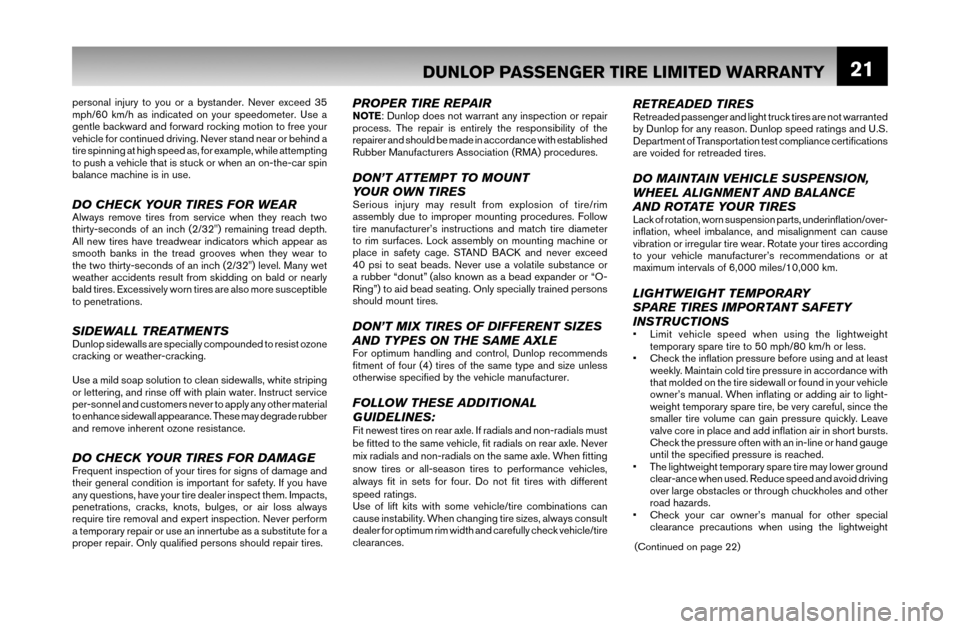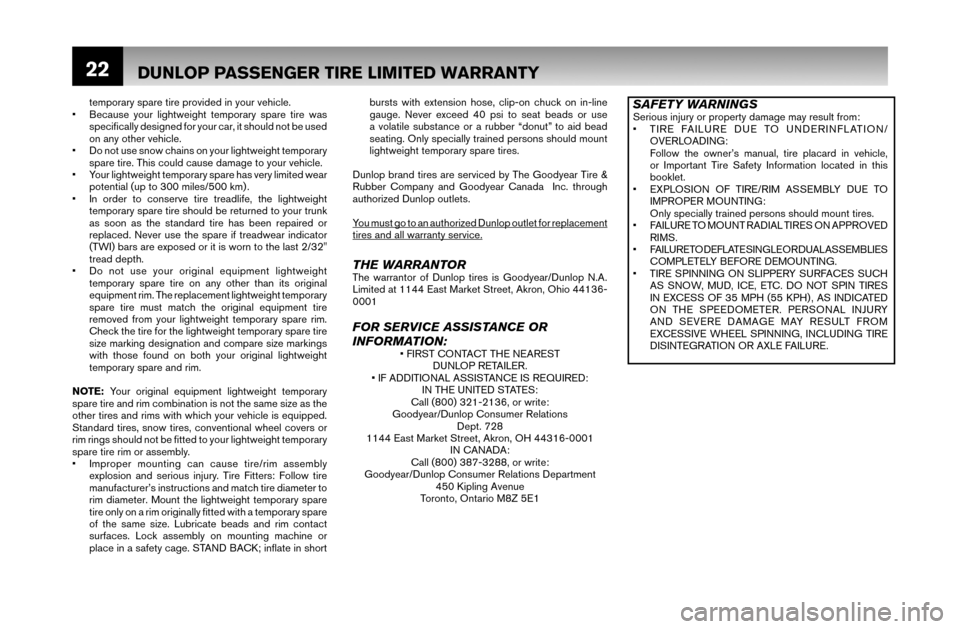weight NISSAN SENTRA 2007 B16 / 6.G Warranty Booklet
[x] Cancel search | Manufacturer: NISSAN, Model Year: 2007, Model line: SENTRA, Model: NISSAN SENTRA 2007 B16 / 6.GPages: 55, PDF Size: 5.93 MB
Page 24 of 55

21
personal injury to you or a bystander. Never exceed 35
mph/60 km/h as indicated on your speedometer. Use a
gentle backward and forward rocking motion to free your
vehicle for continued driving. Never stand near or behind a
tire spinning at high speed as, for example, while attempting
to push a vehicle that is stuck or when an on-the-car spin
balance machine is in use.
DO CHECK YOUR TIRES FOR WEARAlways remove tires from service when they reach two
thirty-seconds of an inch (2/32") remaining tread depth.
All new tires have treadwear indicators which appear as
smooth banks in the tread grooves when they wear to
the two thirty-seconds of an inch (2/32") level. Many wet
weather accidents result from skidding on bald or nearly
bald tires. Excessively worn tires are also more susceptible
to penetrations.
SIDEWALL TREATMENTSDunlop sidewalls are specially compounded to resist ozone
cracking or weather-cracking.
Use a mild soap solution to clean sidewalls, white striping
or lettering, and rinse off with plain water. Instruct service
per-sonnel and customers never to apply any other material
to enhance sidewall appearance. These may degrade rubber
and remove inherent ozone resistance.
DO CHECK YOUR TIRES FOR DAMAGEFrequent inspection of your tires for signs of damage and
their general condition is important for safety. If you have
any questions, have your tire dealer inspect them. Impacts,
penetrations, cracks, knots, bulges, or air loss always
require tire removal and expert inspection. Never perform
a temporary repair or use an innertube as a substitute for a
proper repair. Only qualifi ed persons should repair tires.
PROPER TIRE REPAIRNOTE: Dunlop does not warrant any inspection or repair
process. The repair is entirely the responsibility of the
repairer and should be made in accordance with established
Rubber Manufacturers Association (RMA) procedures.
DON’T ATTEMPT TO MOUNT
YOUR OWN TIRES
Serious injury may result from explosion of tire/rim
assembly due to improper mounting procedures. Follow
tire manufacturer’s instructions and match tire diameter
to rim surfaces. Lock assembly on mounting machine or
place in safety cage. STAND BACK and never exceed
40 psi to seat beads. Never use a volatile substance or
a rubber “donut” (also known as a bead expander or “O-
Ring”) to aid bead seating. Only specially trained persons
should mount tires.
DON’T MIX TIRES OF DIFFERENT SIZES
AND TYPES ON THE SAME AXLE
For optimum handling and control, Dunlop recommends
fi tment of four (4) tires of the same type and size unless
otherwise specifi ed by the vehicle manufacturer.
FOLLOW THESE ADDITIONAL
GUIDELINES:
Fit newest tires on rear axle. If radials and non-radials must
be fi tted to the same vehicle, fi t radials on rear axle. Never
mix radials and non-radials on the same axle. When fi tting
snow tires or all-season tires to performance vehicles,
always fi t in sets for four. Do not fi t tires with different
speed ratings.
Use of lift kits with some vehicle/tire combinations can
cause instability. When changing tire sizes, always consult
dealer for optimum rim width and carefully check vehicle/tire
clearances.
RETREADED TIRESRetreaded passenger and light truck tires are not warranted
by Dunlop for any reason. Dunlop speed ratings and U.S.
Department of Transportation test compliance certifi cations
are voided for retreaded tires.
DO MAINTAIN VEHICLE SUSPENSION,
WHEEL ALIGNMENT AND BALANCE
AND ROTATE YOUR TIRES
Lack of rotation, worn suspension parts, underinfl ation/over-
infl ation, wheel imbalance, and misalignment can cause
vibration or irregular tire wear. Rotate your tires according
to your vehicle manufacturer’s recommendations or at
maximum intervals of 6,000 miles/10,000 km.
LIGHTWEIGHT TEMPORARY
SPARE TIRES IMPORTANT SAFETY
INSTRUCTIONS
• Limit vehicle speed when using the lightweight
temporary spare tire to 50 mph/80 km/h or less.
• Check the infl ation pressure before using and at least
weekly. Maintain cold tire pressure in accordance with
that molded on the tire sidewall or found in your vehicle
owner’s manual. When infl ating or adding air to light-
weight temporary spare tire, be very careful, since the
smaller tire volume can gain pressure quickly. Leave
valve core in place and add infl ation air in short bursts.
Check the pressure often with an in-line or hand gauge
until the specifi ed pressure is reached.
• The lightweight temporary spare tire may lower ground
clear-ance when used. Reduce speed and avoid driving
over large obstacles or through chuckholes and other
road hazards.
• Check your car owner’s manual for other special
clearance precautions when using the lightweight
DUNLOP PASSENGER TIRE LIMITED WARRANTY
(Continued on page 22)
57052 Booklet text pages.indd 2157052 Booklet text pages.indd 218/30/06 3:34:19 PM8/30/06 3:34:19 PM
Page 25 of 55

22
temporary spare tire provided in your vehicle.
• Because your lightweight temporary spare tire was
specifi cally designed for your car, it should not be used
on any other vehicle.
• Do not use snow chains on your lightweight temporary
spare tire. This could cause damage to your vehicle.
• Your lightweight temporary spare has very limited wear
potential (up to 300 miles/500 km) .
• In order to conserve tire treadlife, the lightweight
temporary spare tire should be returned to your trunk
as soon as the standard tire has been repaired or
replaced. Never use the spare if treadwear indicator
(TWI) bars are exposed or it is worn to the last 2/32"
tread depth.
• Do not use your original equipment lightweight
temporary spare tire on any other than its original
equipment rim. The replacement lightweight temporary
spare tire must match the original equipment tire
removed from your lightweight temporary spare rim.
Check the tire for the lightweight temporary spare tire
size marking designation and compare size markings
with those found on both your original lightweight
temporary spare and rim.
NOTE: Your original equipment lightweight temporary
spare tire and rim combination is not the same size as the
other tires and rims with which your vehicle is equipped.
Standard tires, snow tires, conventional wheel covers or
rim rings should not be fi tted to your lightweight temporary
spare tire rim or assembly.
• Improper mounting can cause tire/rim assembly
explosion and serious injury. Tire Fitters: Follow tire
manufacturer’s instructions and match tire diameter to
rim diameter. Mount the lightweight temporary spare
tire only on a rim originally fi tted with a temporary spare
of the same size. Lubricate beads and rim contact
surfaces. Lock assembly on mounting machine or
place in a safety cage. STAND BACK; infl ate in short
DUNLOP PASSENGER TIRE LIMITED WARRANTY
bursts with extension hose, clip-on chuck on in-line
gauge. Never exceed 40 psi to seat beads or use
a volatile substance or a rubber “donut” to aid bead
seating. Only specially trained persons should mount
lightweight temporary spare tires.
Dunlop brand tires are serviced by The Goodyear Tire &
Rubber Company and Goodyear Canada Inc. through
authorized Dunlop outlets.
You must go to an authorized Dunlop outlet for replacement
tires and all warranty service.
THE WARRANTOR The warrantor of Dunlop tires is Goodyear/Dunlop N.A.
Limited at 1144 East Market Street, Akron, Ohio 44136-
0001
FOR SERVICE ASSISTANCE OR
INFORMATION:
• FIRST CONTACT THE NEAREST
DUNLOP RETAILER.
• IF ADDITIONAL ASSISTANCE IS REQUIRED:
IN THE UNITED STATES:
Call (800) 321-2136, or write:
Goodyear/Dunlop Consumer Relations
Dept. 728
1144 East Market Street, Akron, OH 44316-0001
IN CANADA:
Call (800) 387-3288, or write:
Goodyear/Dunlop Consumer Relations Department
450 Kipling Avenue
Toronto, Ontario M8Z 5E1
SAFETY WARNINGSSerious injury or property damage may result from:
• TIRE FAILURE DUE TO UNDERINFLATION/
OVERLOADING:
Follow the owner’s manual, tire placard in vehicle,
or Important Tire Safety Information located in this
booklet.
• EXPLOSION OF TIRE/RIM ASSEMBLY DUE TO
IMPROPER MOUNTING:
Only specially trained persons should mount tires.
• FAILURE TO MOUNT RADIAL TIRES ON APPROVED
RIMS.
• FAILURE TO DEFLATE SINGLE OR DUAL ASSEMBLIES
COMPLETELY BEFORE DEMOUNTING.
• TIRE SPINNING ON SLIPPERY SURFACES SUCH
AS SNOW, MUD, ICE, ETC. DO NOT SPIN TIRES
IN EXCESS OF 35 MPH (55 KPH) , AS INDICATED
ON THE SPEEDOMETER. PERSONAL INJURY
AND SEVERE DAMAGE MAY RESULT FROM
EXCESSIVE WHEEL SPINNING, INCLUDING TIRE
DISINTEGRATION OR AXLE FAILURE.
57052 Booklet text pages.indd 2257052 Booklet text pages.indd 228/30/06 3:34:21 PM8/30/06 3:34:21 PM